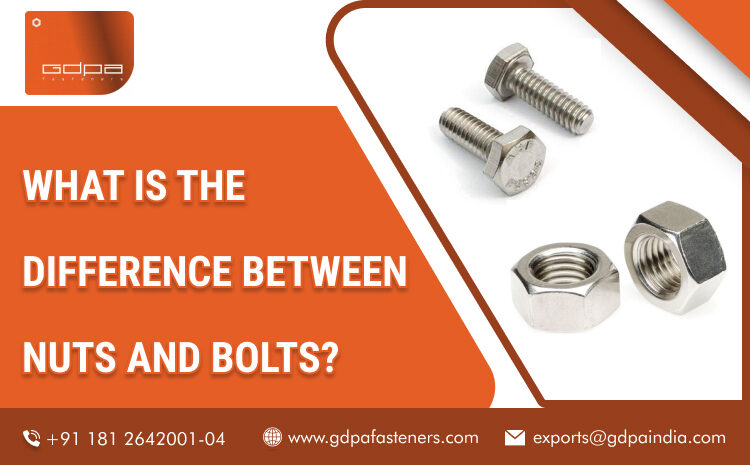
A nut is a tiny metal item with a center hole which is a corrugated hole. These corrugated holes are referred to as threads. Nuts are utilised as a fastening tool. It is crucial to remember that, regardless of their usage as a fastening agent, nuts are ineffective without bolts. To comprehend the knowledge let us discuss the difference between nuts and bolts (Schrauben und Muttern). We must gain knowledge of the walnut shape for better understanding. The body’s outermost region can have either a hexagonal or circle cap form.
Internal threads in the nut let ease tightening on the bolt. The nut’s size is smaller than the bolt. There are compressive forces acting on the nuts and failures can cause by compressive stress.
Nuts and bolts manufacturing companies provide different varieties of nuts: (Hersteller von Schrauben und Muttern bieten verschiedene Arten von Muttern an:)
- Hex Nuts (Sechskantmuttern)
- Nylon Insert Lock Nuts (Kontermuttern mit Nyloneinsatz)
- Jam Nuts (Marmelade Nüsse)
- Nylon Insert Jam Lock Nuts (Kontermuttern mit Nyloneinsatz)
- Square Nuts (Vierkantmuttern)
- Cap Nuts (Hutmuttern)
- Acorn Nuts (Eichel-Nüsse)
- T-Nuts (T-Muttern)
- Cape Nuts(Kap-Nüsse)
- Castle Nuts (Schlossnüsse)
- Wingnuts (Flügelnüsse)
- Flange Nuts (Flanschmuttern)
- Slotted Nuts (Schlitzmuttern)
- Coupling Nuts (Kupplungsmuttern)
The most common type of nut in use today is the hexagonal nut. The fastener manufacturer (Hersteller von Verbindungselementen) said that the key justifications for this are that it offers more granularity, specifically the grip of the tool that can be utilised to remove the nut.
The six sides offer the best solution to each of these issues because having too many sides results in increased wear and tear. Different types of nuts exist based on their intended usage; these are distinct from domestic standard nuts, which are only utilised for industrial needs.
For a more deep difference between bolts and nuts (Schrauben und Muttern), professionals said that bolts are generally utilised for fasteners with only a portion of their shaft threaded. Screws are the ordinary name for fasteners with a threaded shaft. The shank is the portion of a bolt shaft that is not threaded. The bolt’s shaft controls axial movement, while the bolt’s head and nut, if present, avoids pieces’ radial movement.
The unthreaded shank offers a gentler interaction and more precise interaction with the components. If a substantial shear force is applied to the bolt, it is crucial that the shank extends well beyond the interface between the parts since the shank does not contain stress concentrations that could cause failure.
In order to stay in place, bolts normally rely on an axial force that creates enough friction at the threads. To produce this axial force, a torque is applied to the head. Whether the bolt is screwed into a nut or one of the components being secured, a force acts between the bolt head and whatever it is screwed into. This lengthens the bolt and compresses the components with clearance holes. To stop the bolt from losing, an alternative is to employ a locking nut or thread-locking compound.
In nuts and bolts (Schrauben und Muttern), the hex bolts are the most typical type of bolt. Its hexagonal head provides flat surfaces on which fastening tools can impart torque. For older bolts, a square head was utilised because it was simpler to manufacture; this is still the case for applications where a very high torque needs to be exerted with a spanner. Nuts and bolts (Schrauben und Muttern) manufacturing company deliver there numerous additional types of bolts available for particular applications, such as:
- Carriage Bolt (Wagenschraube)
- Shoulder Bolt (Schulterbolzen)
- J Bolt (J Bolzen)
- Sex Bolt (Sex-Bolzen)
- Standard Hex Bolts & Screws (Standard-Sechskantschrauben und -schrauben)
- Precision Hex Bolts & Screws (Präzisions-Sechskantschrauben und -schrauben)
- Cup Square Bolts Cup Round Bolts (Cup-Vierkantschrauben Cup-Rundschrauben)
- Cup Oval Bolts (Cup-Ovalschrauben)
- Sq. Bolts (Quadrat. Schrauben)
- Square Bolts Hanger Bolts (Vierkantschrauben Stockschrauben)
- Tee Bolts (T-Bolzen)
- High Strength Friction Grip Bolts (Hochfeste Reibungsgriffschrauben)
- Saddle Bolts (Sattelschrauben)
- Break Off Bolt (Bolzen abbrechen)
- Liner Bolts (Liner-Schrauben)
Final Say
GDPA Fasteners is one of the leading fastener manufacturer in the fastening manufacturing industry. It is important for every individual and professional to comprehend the knowledge of nuts and bolts to effectively and safely work. The shaping process heavily depends on the type of metal because some metals are more malleable and elastic than others. GDPA Fasteners utilise very fine materials to make their products. Please feel free to ask any questions you may have by emailing or direct calling.